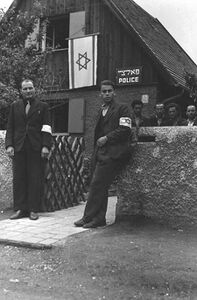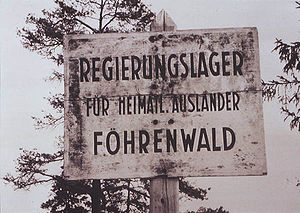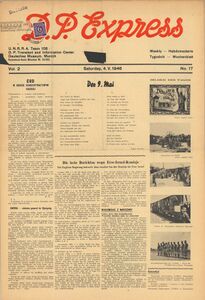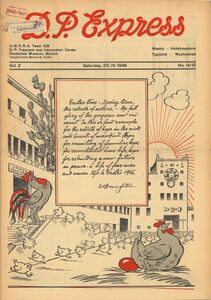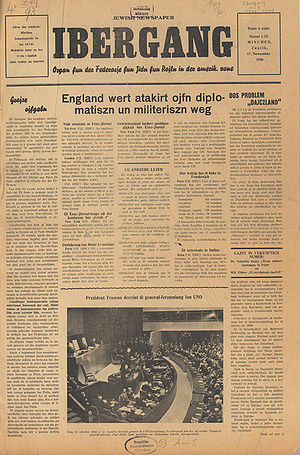
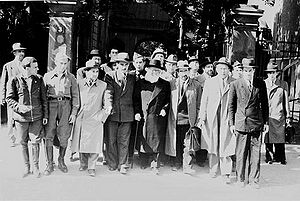
At the end of the Second World War, the collective term "Displaced Persons" (DPs for short) was used to describe all those foreign civilians who were staying in places outside their home country as a result of the war. These primarily included former forced labourers, concentration camp prisoners, prisoners of war and other workers who had come to Germany during the war years, some of them voluntarily, others involuntarily. This group of DPs was a great challenge for the occupying powers, who also had to provide aid to the German population. The aim was to enable as many DPs as possible to return home, which was not always achievable due to tensions with the USSR and the European states it occupied. In the reception camps, self-governmental structures borne by the DPs developed, with cultural events and a colourful press landscape.
Introduction
When the allied armies occupied Germany in 1945, they found 6.5 to 7 million "Displaced Persons" (DPs) in the later territory of the three western occupation zones. The "DP" status covered all those people who had fled, been displaced, or abducted from their homeland as a result of the Second World War and its consequences. In practice, DPs were considered to be former forced labourers, concentration camp prisoners, prisoners of war and civilian Eastern European workers who had either voluntarily supported the German economy after the war began or had fled from the Soviet army in 1944. A comparatively small group among the DPs in the western occupation zones were the 50,000 to 75,000 Jewish survivors. German refugees did not fall under this status. In October 1946 there were about 278,000 civilians living in Bavaria who were considered to be of DP status.
DP status and accommodation
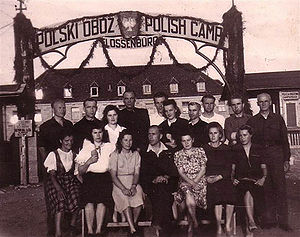
The DP status meant receiving care, additional food, clothing allocations and accommodation in specially set up camps, the DP camps or "assembly centres". They were built in hospitals, sanatoriums, schools, industrial workers' housing estates, former barracks, prisoner-of-war and forced labour camps, but also occasionally on the grounds of former concentration camps. The first Zionist training farm in post-war Germany, the "Buchenwald Kibbutz", was established in Buchenwald (Thuringia), which functioned as a DP camp after liberation, until it was taken over by the Soviet Army in July 1945. From April 1946 to the end of 1947, parts of the former Flossenbürg concentration camp (Neustadt an der Waldnaab district), which had initially been converted into a prisoner of war camp after liberation, functioned as one of the largest camps for Polish displaced persons in Bavaria. Whilst the local population received about 1,200 calories a day, DPs were usually entitled to at least 2,000 calories. Implementing this in practice, however, relied heavily on the general food situation and the Allied supply routes. The DPs situation only began to improve when the United Nations Relief and Rehabilitation Administration (UNRRA) allowed international aid organisations to operate in the DP camps from autumn 1945 onwards. They not only received extra rations, but also psychological support, various leisure activities and, most importantly, they could move freely in- and outside of the camps. Initially the DPs were housed in the camps according to their national affiliation. Jewish survivors thus had to come to terms with the fact that they were accommodated with their Polish, Latvian and Ukrainian compatriots, who had often proven to be Nazi collaborators. Tensions also arose because neither the army personnel nor the hastily set up DP camps offered the special help that the Jewish survivors were entitled to due to their persecution. The living conditions improved gradually, especially in the American zone, when genuinely Jewish DP camps were established there from autumn 1945 onwards. The British military authorities, in their zone, generally refused to grant such a status to anyone who had crossed their zone border after 30 June 1946. In 1945, there was a relatively small number of DPs in the French occupation zone, including a few thousand Jewish DPs. In the Soviet occupation zone, refugees were not given a DP status.
Repatriation agreements
A Soviet-American repatriation agreement from 11 February 1945 had stipulated that all DPs found in the soon to be occupied territories should be returned to their homeland. Such an agreement was also reached with France. Initially the Western Allies tolerated the forced repatriation of Soviet DPs with all the consequences for those affected, but soon recognised the explosive nature of the agreement and distanced themselves from it. The Soviet side, however, insisted on the agreement. Finally, a UN resolution from February 1946 declared the nature of repatriation to be voluntary. The non-Jewish DPs from the Western states were able to return to their native countries as early as the end of June 1945. Contrary to that, difficulties arose in the repatriation of former forced labourers and concentration camp prisoners from the Eastern Bloc countries. For the Jewish DPs, repatriation was only possible to Western countries of origin. Repatriation of the Jewish survivors, who mainly stemmed from Central and Eastern Europe, to their home countries, would have been unreasonable due to the destruction of the Jewish communities, the political upheaval and the anti-Semitism that prevailed there.
Support
In the western zones, the DPs were cared for by the armies of the respective occupation zones, from autumn 1945 or spring 1946 onwards by the United Nations Relief and Works Agency, UNRRA, – under military administration – and after July 1947 by the International Refugee Organisation (IRO). At the end of 1945, the UNRRA was in charge of 227 DP camps on the territory of the later Federal Republic of Germany; in June 1947, the number was 416 in Germany's American zone and 272 in the British zone. On 1 July 1947, there were still 611,469 DPs in Germany, of which 336,700 were in the American zone, 230,660 in the British zone and 44,109 in the French zone, including 196,780 Poles, 168,440 Jews (about 70,000 in Bavaria) and 157,859 Balts.
Jewish DPs
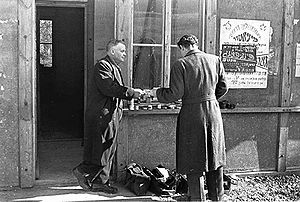
In Bavaria, where the biggest portion of Jewish DPs in the American occupation zone lived, the survivors suffered more than in other regions due to military policies that were geared solely towards law and order and did not meet their physical and psychological needs. General George S. Patton (1885-1945, Commander of the US Third Army and Military Commander in Bavaria) was in command there. Patton, whose anti-Semitic stance and trivialisation of the NSDAP led to his transfer to Bad Nauheim (Hesse) in the autumn of 1945, had the DP camps fenced in with barbed wire and guarded by armed personnel. He believed that the Jewish DPs, who he considered "Untermenschen" (“subhumans”) (Abraham Hyman, The Undefeated, 1993), would otherwise spread across the country like locusts and rob or even murder Germans. It was only after Patton's transfer and reports to the US government about the unacceptable conditions in the DP camps, above all, however, after the introduction of a genuinely Jewish DP status, which led to the establishment of separate camps for Jewish DPs, that living conditions improved in the American zone. In the meantime, Jewish-American aid organisations such as the American Jewish Joint Distribution Committee (for short: Joint) were active as well. Synagogues were established in the DP camps, schools, libraries and theatre groups were founded, and football leagues and sports festivals were held. The DPs elected camp, zone and inter-zone self-representation committees (including the Central Committee for Liberated Jews), set up their own police force in the camps and developed an impressive cultural life, which was entirely rooted in the Eastern European Yiddish tradition. Polish, Baltic and Ukrainian DPs were supported by aid organisations such as the Quakers (American Friends Service Committee), the YMCA/YWCA or the American Polish Relief, as well as representatives of Catholic and Protestant organisations from the USA.
-
The camp police in the Jewish DP camp (Displaced Persons-L.) in Munich-Freimann, photograph, 1946. (Haus der Bayerischen Geschichte)
-
Föhrenwald DP camp. (Photo: Stadtarchiv Wolfratshausen (City Archives Wolfratshausen))
Press
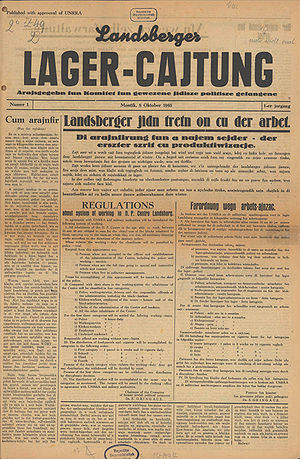
The first major DP newspaper, the "DP-Express", was first published in July 1945 in München, one of the most important locations for the DP press. To reach DPs of various nationalities, the editorial staff at the Deutsches Museum wrote articles in German, English, Slovakian, Polish, but also in Yiddish. On 18 December 1947, the "DP-Express" was renamed "Displaced Person's Newspaper-EXPRESS polish edition" and only appeared in Polish until it was discontinued in 1950/51. With this, the publishers were taking into account the considerably different DP structure at that time. The Polish DPs were by now the strongest remaining DP group apart from the Jewish survivors. The Jewish press landscape was particularly impressive. More than 40 newspapers – camp agencies, regional and supra-regional papers – were published mainly in Yiddish, in Latin block letters in the beginning - due to a lack of Hebrew sorts -, among them the "Landsberger Lager-Cajtung" (later "Jidisze Cajtung"), "Unzer Weg", "Ibergang. Organ fun Pojliszn Jidntum in Dajzland", "Dos Fraje Wort", "Bamidbar. Wochncajtung fun di bafraijten Idn" and "Neue Welt. Eine Wochenschrift der befreiten Juden".
-
D.P.-Express, Saturday, 4 May 1946. (Bayerische Staatsbibliothek, Film R 95.688-13)
-
Easter edition of the D.P.-Express, Saturday 20 April 1946. (Bayerische Staatsbibliothek, Film R 95.688-13)
Mass influx
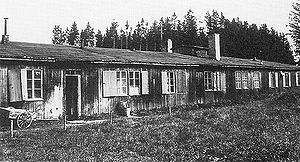
When, after renewed pogroms in Poland and other Central and Eastern European states, a mass influx of Jewish refugees into the western occupation zones of Germany began in the summer of 1946, and the number of Jewish DPs tripled to about 150,000 to 200,000 people, aid organisations and military government were once again faced with an almost unsolvable problem. Due to the restrictive policies in the British zone, most refugees were concentrated in the US zone. New DP camps were set up; others that already existed were expanded. The largest Jewish DP camps, harbouring between 3,000 and 6,000 residents, were established in Bavaria, including Bad Reichenhall (Berchtesgadener Land district), Feldafing (Starnberg district), Föhrenwald/Wolfratshausen (Bad Tölz-Wolfratshausen district), Landsberg on the Lech, Leipheim (Günzburg district) and Pocking (Passau district). Nearly all the Jewish DP camps were dissolved between 1949 and 1951, when most Jewish DPs were able to emigrate after the Israeli War of Independence and the relaxation of the US immigration policy. The remaining DPs, so-called hard-core cases, i.e. those who could not emigrate for health reasons, were accommodated at Föhrenwald, the last remaining Jewish DP camp, and remained there – now under German administration – as "homeless foreigners" until they were distributed to various German cities in early 1957 and Föhrenwald was closed in February 1957.
The relationship with the German population
The German population met the DPs with considerable prejudice. Exaggerated rumours of alleged looting by the DPs were still the result of Nazi propaganda against "subhumans", when the Nazis stigmatised not only Jews but also Poles and Soviet citizens. Xenophobia and the rejection of responsibility towards the victims of NS rule mixed with old prejudices and led to allegations of disproportionate crime rates amongst Jewish people in particular, which by no means corresponded to reality. In March 1947, a survey conducted by the Opinion Surveys Headquarters OMGUS, for example, had revealed that more people with anti-Semitic attitudes lived in Munich than in other large cities in the U.S. zone. It was not least for this reason that High Commissioner John Jay McCloy (1895-1989) declared in 1949 that the German majority population's treatment of the Jewish survivors was the "touchstone of their morals and their genuine will to build democracy" (Werner Bergmann, 1994). The history of the Jewish DPs continues to have an impact today: German social insurance companies and social courts are still arguing about the question of whether Jewish DPs who worked in the DP camps should receive a pension from the German state. At the time, the aid organisations paid flat-rate social security contributions. The overwhelming majority of the DPs regarded Germany as just a stopover and emigrated when appropriate emigration opportunities arose. Those who had already settled in communities outside the camps and opened small shops, for example, or who could not emigrate due to their poor health, remained. Some 1,000 Jewish DPs who left the last DP camp in Föhrenwald (under German administration since 1951) in 1957 as "homeless foreigners" were accommodated in several German cities, including Munich and Nuremberg. They later integrated themselves into the re-established Jewish communities. It was not until the early 1980s that the first studies on the history of the DPs were carried out, initially focusing on Jewish survivors, and only much later on other DP groups.
Documents
Notes For Teachers
References
- Heike Ander/Michaela Melián, Föhrenwald. Publikation anläßlich der Ausstellung Michaela Melián: Föhrenwald, 10. September-30. Oktober 2005 in München, Frankfurt am Main 2005.
- Bedrich Burianek, From liberator to guardian. The US Army and displaced persons in Munich 1945, Ann Arbor 1992.
- Jaqueline Dewell Giere, Wir sind unterwegs, aber nicht in der Wüste. Erziehung und Kultur in den jüdischen Displaced Persons-Lagern der amerikanischen Zone im Nachkriegsdeutschland 1945-1949, Frankfurt 1993.
- Angelika Eder, Flüchtige Heimat. Displaced Persons in Landsberg am Lech 1945 bis 1950 (Miscellanea Bavarica Monacensia 170), München 1998.
- Fritz Bauer Institut (Hg.), Überlebt und unterwegs. Jüdische Displaced Persons im Nachkriegsdeutschland (Jahrbuch zur Geschichte und Wirkung des Holocaust 1997), Frankfurt am Main/New York 1997.
- Walter Fürnrohr/Felix Muschialik, Überleben und Neubeginn. DP-Hospital Gauting ab 1945. Mit Faksimile-Abdruck der Patientenzeitung "Unser Leben" von 1947-1948, München 2005.
- Gerhard Jochem, Wege slowenischer NS-Opfer in Nürnberg und Bayern, in: Gerhard Jochem/Georg Seiderer (Hg.), Entrechtung, Vertreibung, Mord. NS-Unrecht in Slowenien und seine Spuren in Bayern 1941-1945, Berlin 2005, 237-272.
- Holger Köhn, Die Lage der Lager. Displaced Persons in der amerikanischen Besatzungszone Deutschlands, Essen 2012.
- Angelika Königseder/Juliane Wetzel (Hg.), Lebensmut im Wartesaal. Die jüdischen DPs im Nachkriegsdeutschland, Frankfurt am Main 1995.
- Tamar Lewinsky, "Goles Daytshland/Galut Germanija". Zur Entstehung einer jüdischen Diasporakultur in den DP-Camps, in: Miriam Rürup (Hg.), Praktiken der Differenz. Diasporakulturen in der Zeitgeschichte (Veröffentlichungen des Zeitgeschichtlichen Arbeitskreises Niedersachsen 26), Göttingen 2009, 99-114.
- Tamar Lewinsky, Jüdische Displaced Persons im Nachkriegsmünchen, in: Münchner Beiträge zur jüdischen Geschichte und Kultur 1 (2010), 17-25.
- Zeev W. Mankowitz, Life between Memory and Hope. The Survivors of the Holocaust in Occupied Germany, Cambridge 2002.
- Edith Raim, 1946: Der "Aufruhr" von Landsberg. US-Besatzungsmacht und deutsche Bevölkerung gemeinsam gegen jüdische DPs, in: Tribüne. Zeitschrift zum Verständnis des Judentums 128 (1993), 153-162.
- Roman Paul Smolorz, Displaced Persons (DPs). Autoritäten und Anführer im angehenden Kalten Krieg im östlichen Bayern (Regensburger Studien 11), Regensburg 2., verbesserte und erweiterte Auflage 2009.
- Beno Salmander/Michael Brenner/Jutta Fleckenstein, Kinderjahre im Displaced-Persons-Lager Föhrenwald, München 2011.
- Karin Sommer, Vom Vernichtungslager ins Flüchtlingslager. Jüdische Überlebende des Holocaust als "Displaced Persons", in: Peter Fassl (Hg.), Geschichte und Kultur der Juden in Schwaben. 2. Band: Neuere Forschungen und Zeitzeugenberichte (Irseer Schriften 5), Sigmaringen 2000, 401-412.
- Jim G. Tobias/Nicola Schlichting, Heimat auf Zeit. Jüdische Kinder in Rosenheim 1946-47. Zur Geschichte des "Transient Children's Center" in Rosenheim und der jüdischen DP-Kinderlager in Aschau, Bayerisch Gmain, Indersdorf, Prien und Pürten, Nürnberg 2006.
- Jim G. Tobias, Vorübergehende Heimat im Land der Täter. Jüdische DP-Camps in Franken 1945-1949, Nürnberg 2002.
- Ronald Webster, American relief and Jews in Germany 1945-1960. Diverging perspectives, in: Year-book Leo Baeck Institute 38 (1993), 293-321.
- Juliane Wetzel, "Mir szeinen doh". München und Umgebung als Zuflucht von Überlebenden des Holocaust 1945-1948, in: Martin Broszat/Klaus-Dietmar Henke/Hans Woller (Hg.), Von Stalingrad zur Währungsreform. Zur Sozialgeschichte des Umbruchs in Deutschland (Quellen und Darstellungen zur Zeitgeschichte 26), München 1988, 327-364.
- Mark Wyman, DPs: Europe's Displaced Persons 1945-1951, Ithaca 1998.
Sources
- Bayerisches Hauptstaatsarchiv, MArb, UNRRA.
- Bayerisches Hauptstaatsarchiv, OMGBY, Intelligence Division.
- Irving Heymont, Among the Survivors of the Holocaust - 1945. The Landsberg DP Camp Letters of Major Irving Heymont, United States Army (Monographs of the American Jewish Archives 10), Cincinatti 1982.
- Institut für Zeitgeschichte, Sammlung Jacobmeyer Fi 0.1.
- YIVO Institut for Jewish Research, DP-Camps Germany, Mikrofilmkopie Zentrum für Antisemitismusforschung, TU Berlin.
- YIVO Institute for Jewish Research, Leo W. Schwarz Papers, Mikrofilmkopie Zentrum für Antisemitismusforschung, TU Berlin.
Further Research
External Links
Related Articles
Cite
Juliane Wetzel, Displaced Persons (DPs), published 26 March 2013, english version published 22 June 2023; in: Historisches Lexikon Bayerns, URL: <https://www.historisches-lexikon-bayerns.de/Lexikon/EN:Displaced_Persons_(DPs)> (15.12.2025)

